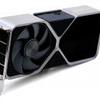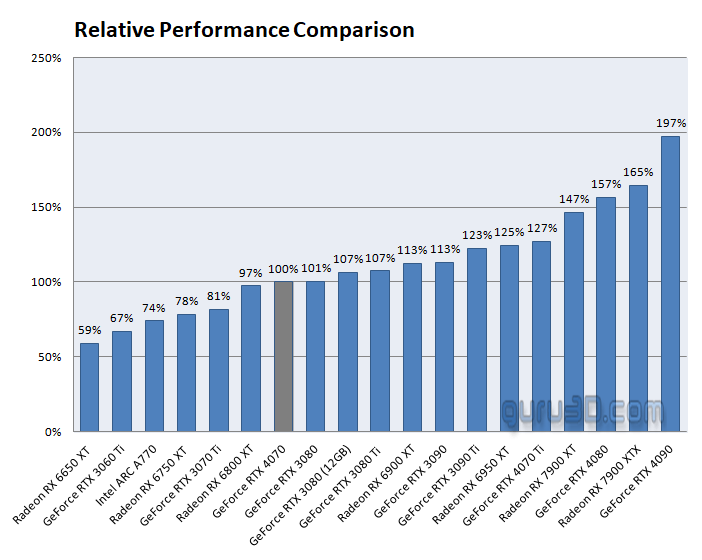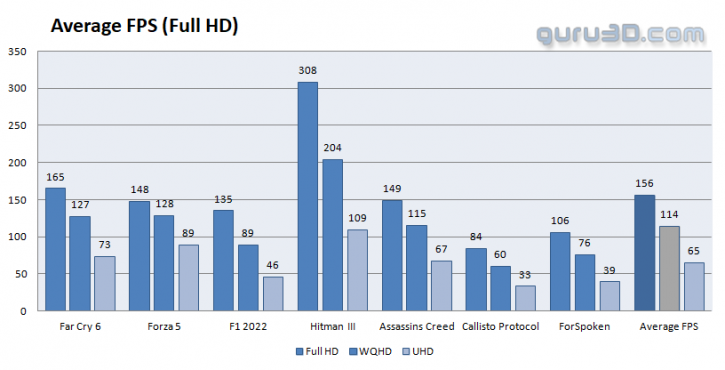Final words and conclusion
Final words
NVIDIA's latest addition to the ADA product line, the GeForce RTX 4070, has finally arrived, offering more affordability to end-users, although still at a considerable cost of €599. Despite heavily promoting the DLSS technology as a game-changer, it is important to note that the raw rasterizer shader performance is just as crucial in future products. Boasting a powerful architecture, advanced ray tracing capabilities, and enhanced DLSS3 technology, the GeForce RTX 4070 showcases significant improvements in performance compared to its predecessors. However, its performance may fluctuate in less CPU-bound situations, and it may be slower in DX11 but faster in DX12. Compared to the Radeon Series the RTX 4070's ray tracing performance has a bit more stamina, making notable advancements in this field. Additionally, with the DLSS3+ Frame generation technology, the GPU can create remarkable visual experiences in games that support it.
Performance
The RTX 4070 is a graphics card that can waves in the gaming world due to its rendering quality and gaming performance when combined with DLSS3 frame generation. The RTX 4070 provides a bit more value for the money. It is a well-balanced card that can handle gaming at 4K resolution, although it is targeted towards WQHD. Compared to AMD's offerings, the Nvidia GPU struggles to keep up with the Radeon RX 7900 XT, but it still has many positive aspects. DLSS (3) and ray tracing features work exceptionally well, AMD cannot match Nvidia in this regard. The RTX 4070 is an excellent option for gamers who play at UWHD, QHD, and even UHD monitor resolutions.
The old rasterizer engine breaks right through the previous limit of extreme performance. The RTX 40 series now has a new generation of Ray tracing and Tensor cores that are more powerful. So, do not let the specific RT and Tensor core counts fool you; it's all about how much performance one unit offers. Since they are close to the shader engine, they have become more efficient, which shows. Tensor cores are harder to measure, but from what we have seen, everything seems to be in good shape, as DLSS3 shows exciting values.
Overall, the GeForce RTX 4070 makes sense at resolutions as low as 2K 2560x1440, and sometimes up to 4K (3840x2160). NVIDIA proclaims this as a 100+ FPS WQHD card, with which we concur.
Cooling & noise levels
Under heavy full load, the card tested uses about ~195 Watts (average). This Wattage is directly related to how much heat the GPU, which sits inside a closed case, gives off. The founder model in this review boasts a two-slot cooler that performed exceptionally well during our tests, effectively cooling the card's components. Furthermore, the card's fan stop mode is entirely silent in 2D applications. For acoustics, we reached 33~34DBa, which is a very nice acoustic level by today's standard. Expect the card to get close to 65-70°C when stressed in a closed chassis. This value can differ depending on how well air moves through your chassis. FLIR imaging doesn't show anything alarming. Also, keep in mind that if you go for a custom card from a board partner, the power consumption levels will likely be higher due to increased TGPs and stuff like RGB and liquid cooling pumps.
Energy consumption
We touched the topic in the previous chapter; the power draw under intensive gaming for GeForce RTX 4070 is quite okay. We measured it close to the 190 Watt range (TBP). This is the tradeoff for a bit more bite in performance for this graphics card model in particular. Gaming wise, that number will fluctuate a bit; however, 185 Watt will do in no time. We expect the board partner cards to show higher numbers as they get more TGP allowance. When looking at TGP we write down an average power consumption of 185 (TGP) at Ultra HD based on the reference test. The card's TDP of 185 (see below) was measured over five games. The RTX 4070 comes with a converter that allows turning 8-pin PCIe power connectors into a single 12-plus-four-pin 12VHPWR. However, many board partner cards will still have the traditional 8-pin header on board.
Coil whine
Any GeForce RTX 4070 can exhibit coil squeal. It's just a matter of how much exactly. Well, it's at a level you can hear when you hit high framerates. In a closed chassis, that noise would fade away in the background. For this particular card, we've not been able to notice it.
Pricing
In the realm of computer hardware, a commonly held belief states that there's no such thing as an bad graphics card—only one that's inappropriately priced. The NVIDIA GeForce RTX 4070 has a price tag of $599 USD / 669 euro, which many gamers will find steep for a graphics card. Comparatively, that's still more expensive than a modern console, which can be a turnoff for budget-conscious gamers.
When comparing the RTX 4070 with its predecessors, its price tag appears to be on the higher side. For instance, upon release, the suggested retail price of the RTX 4070 is roughly ~30% higher than the RTX 3070. Also, remember that premium AIB card designs come with an additional cost. Unfortunately, in Europe, the price range is even higher, ranging from 650-750 EUR. The value proposition of the RTX 4070 comes debatable.
Tweaking
The card tweaks reasonably. You receive a power limiter in Watts with the tested card, set at an amazing +10% power limiter, so that's your first and quickest option to tweak. You get extra perf on the card's default power budget. The clock frequency can take a good +150 maybe 200 MHz extra. Apply it, and you'll see the GPU boost clock hovering at the 2900~3000 MHz domain (frequencies vary per game title as they are dynamic). The memory could be tweaked to 23 Gbps, so all these are excellent values that brought ~5% additional performance on challenging GPU situations, measured from reference performance.
Conclusion
The GeForce RTX 4070 founder edition graphics card offers nice performance and visual quality, adding to that improved power efficiency and low thermals, making it an energy-friendly option. It effortlessly handles high-resolution gaming and creative workflows, the VRAM capacity (12GB) we deem is very acceptable. When choosing between the RTX 4070 and Radeon RX 7900 XT, it's important to consider factors such as raytracing performance and DLSS3, which the RTX 4070 excels at. However, a Radeon RX 7900 XT offers much faster rasterizer engine performance with an additional L3 cache, making it a strong(er) contender for the RTX 4070. The GeForce RTX 4070 is priced at $200 lower, so perhaps it offers more value. In this respect, we feel the card is competing more with the 6800/6900 XT than the 7900XT, though. Performance-wise, you can compare the card with RTX 3070 Ti / 3080 performance levels depending on where you measure. Overall, the RTX 4070 series edition is an interesting option for those looking for a visually appealing graphics card, as the founder editions sure look nice, also. This graphics card has plenty of oomph up-to even Ultra HD gaming (especially with DLSS3 / Frame generation enabled) with the option for a mild overclock. As such it comes recommended. Pricing, however, remains a sore point.
- Download NVIDIA GeForce drivers
- Sign up to receive a notification when we publish a new article.
- Or go back to Guru3D's front page
- Hilbert, LOAD"*",8,1.





